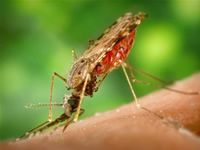Article
Summer Viruses No Match for Seasonal Fun
Author(s):
Although headlines across the country show new reasons why people need to be aware of dangers in the great outdoors, there is considerable evidence that summer days and nights can continue to be a time of great enjoyment.

For many people, the summer is a chance to get outside and enjoy the fresh air and all Mother Nature has to offer. Although headlines across the country show new reasons why people need to be aware of dangers in the great outdoors, there is considerable evidence that summer days and nights can continue to be a time of great enjoyment.
Stephen Gluckman, MD, Medical Director of Penn Global Medicine, said that while people can be exposed to a variety of infectious diseases by travelling and enjoying everything from swimming holes to parks, there are steps that can be taken to be as safe as possible while also having as much fun as possible.
One particularly nasty highlight this summer has come from the Caribbean in the form of Chikungunya. Gluckman said the prevalence of the virus, which is spread by mosquitos, has grown rapidly in just the past five years alone. Working at the University of Pennsylvania, Gluckman said he has seen four cases just in the past few weeks as patients returned from a trip to the Dominican Republic.
Calling it a “big epidemic,” Gluckman said the disease has the ability to spread easily as people get bitten by what would otherwise be a harmless bug. “I don’t think there’s any question that we’re going to see more of it,” he said of the possibility of more cases in the United States.
Spreading the disease, he said, is as simple as a person travelling to the Caribbean, getting bitten by an infected mosquito, coming home and being bitten by another bug and having that flying carrier bite another person. The doctor said he told his infected patients that they were now “carriers,” and had the potential to spread the disease for a period of around a week.

There are also two diseases that can be spread by ticks that have made headlines in the summer of 2014. One is the more well-known Lyme disease; the other is the lesser known babesiosis. While several cases have been reported in the southern portion of New Jersey, Gluckman said babesiosis is a much more common malady in the areas of Nantucket, Martha’s Vineyard, and Cape Cod.
“The vast majority don’t know they’ve had it,” he noted. Many patients will think they have flu-like symptoms without considering that a small insect may have bitten them and made them sick. There are some portions of the population who Gluckman said will not get away from babesiosis quite as easily.
“If you’re immunosuppressed or if you don’t have a spleen it can be a bad, bad disease,” he said. Gluckman advises people who do not have a spleen to avoid areas where the virus is prevalent, calling it “just an unnecessary risk.”
Gluckman said his hospital treats a handful of people with the disease every year. Often, the disease has worked its course and patienst are already on the road to recovery by the time they have come in to get checked.
The best way to prevent getting either Lyme disease or babesiosis is to not get bitten by ticks, Gluckman said. For people going into areas where ticks live, particularly wooded areas, he said it is important to use bug spray that has at least some amount of DEET in its chemical makeup. “All the others are only mildly to marginally effective,” he said.
Although some people have raised concerns about the safety of using products that contain DEET to repel bugs, Gluckman noted, “There is a totally misguided concept that it’s dangerous. There has been no credible report of a serious untoward event with DEET.” He added that even a product with as little as 25% DEET can be effective in keeping people safe.
Babesiosis may be gaining notoriety, but many more people are aware of Lyme disease and the many myths that surround the disease, said Gluckman. While babesiosis is caused by parasites and is more similar to malaria, he said Lyme is caused by bacteria. The two diseases, he noted, can be carried by the same species of ticks and in some cases can infect people with both at the same time.
Gluckman said in addition to using quality bug spray, people who live in high-risk areas for ticks can better protect themselves from bites by wearing long sleeves and pants and getting in the habit of checking themselves for ticks after being outdoors. Hiking fully covered in the summer may not be the ideal way to take on the trail but Gluckman said that is why it is important to be aware of your surroundings and anything that might land on you during your time in the woods.
He also said it is important to remember that ticks do not automatically bite people in the places they land and also do not infect that person immediately after biting. He said it can take a minimum of 36 hours for the infecting bacteria to make its way from the bug’s gut into its mouth when it could then infect its host.
For doctors treating Lyme disease, Gluckman said two advantages are the ability to treat the disease and also the ability to recognize its symptoms, including its “characteristic rash.” While most people associate Lyme disease with bullseye rashes, Gluckman said that is only the case for one-third of patients infected with the disease. “My general approach to this is to look for any large, red patch on the patient, whether it has a bullseye or a vesicle in the middle, unless the patient has a better explanation” for the symptoms.
One misconception Gluckman said he tries to educate his patients about is the belief that they can get Lyme disease more than once. “There have been very good studies that have shown that it is a different bug,” rather than a recurrence of the first case, he said.
“When I see a patient suffering from chronic Lyme disease, I tell them that they’re going to see doctors who are going to tell them things 180 degrees from what I’m telling them. I can only tell them what I think and why I think it and where this confusion is coming from.”

It may not be carried by bugs but Gluckman said whooping cough is a serious health issue, especially for infants. “If they get it they can die,” he said. “If adults get it we cough for 3 or 4 months and nobody wants to be around us.”
The Centers for Disease Control a few years ago urged all adults to get a shot for whooping cough, particularly parents or expectant mothers. “The shot doesn’t last all that long, but it’s very effective,” he said. “If you can’t get whooping cough, you can’t give it to somebody.”
One of the most serious, and most unusual, health stories this summer has been the death of a 9-year-old girl from Kansas from a brain-eating amoeba called Naegleria fowleri. This particularly deadly strand lives in what Gluckman said most people would think of as “old swimming holes,” or fresh water ponds.
Gluckman said most cases of people getting sick happen in the southern part of the country where water temperatures are warmer and more suitable for the amoeba to develop. Most cases, he added, happen when people, particularly children, jump into the water which then goes up their noses allowing the bacteria to reach the brain.
“It’s very, very rare,” he said. While it may not be the most stylish part of a summer wardrobe, Gluckman said something as simple as nose plugs can go a long way in helping to prevent people from getting infected. He said while it is a concern, it should not be enough to stop people from swimming in places they are used to going. “You could just say there’s a risk in everything we do and not let this get in the way of your summer.”
Out of all the other conditions covered in this article, Gluckman said this can be the hardest to diagnose and there are very limited treatment options, if any. “You’re looking at the spinal fluid for the amoeba,” he said. “If you had a pathology department who didn’t have this and weren’t thinking about it they might dismiss these as normal blood cells in the spinal fluid.”
For doctors like Gluckman, dealing with infectious diseases is what they do on a daily basis. For others who may not be as familiar with the conditions, he said there are resources they can reach out to in order to provide their patients the best care possible. “Some of this stuff is nuanced. Not every doctor is supposed to know about malaria,” he said. Sometimes help can be as simple as taking a picture of a patient’s rash and sending it to a specialist to help with diagnosis. “Other things require more a more hands-on approach,” he said.
Infectious disease specialists see a wide range of afflictions with patients and Gluckman said they can change as often as the seasons. “It varies. In the winter it’s more respiratory viruses, so it’s not that we’re not busy, but it’s different viruses,” he said.
Patients who have to deal with the different infectious diseases will see their summers impacted to different levels depending on their conditions, but for the general public Gluckman said it can be business as usual as the weather continues to heat up.



